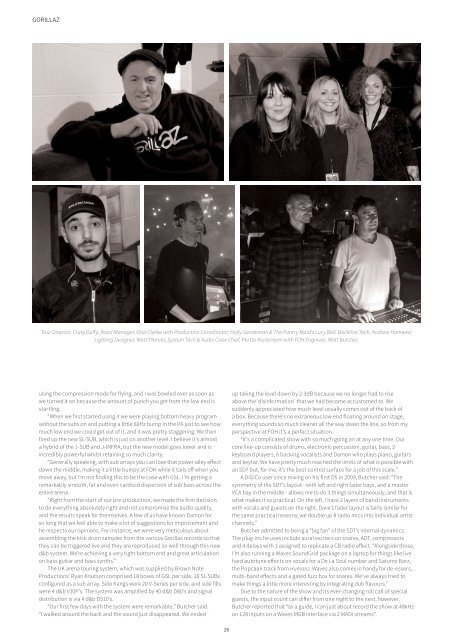Create successful ePaper yourself
Turn your PDF publications into a flip-book with our unique Google optimized e-Paper software.
GORILLAZ<br />
Tour Director, Craig Duffy; Road Manager, Orla Clarke with Production Coordinator, Holly Sandeman & The Pantry Maid’s Lucy Bell; Backline Tech, Andrew Hamwee;<br />
Lighting Designer, Matt Pitman; System Tech & Audio Crew Chief, Perttu Korteniemi with FOH Engineer, Matt Butcher.<br />
using the compression mode for flying, and I was bowled over as soon as<br />
we turned it on because the amount of punch you get from the low end is<br />
startling.<br />
“When we first started using it we were playing bottom heavy program<br />
without the subs on and putting a little 60Hz bump in the PA just to see how<br />
much low end we could get out of it, and it was pretty staggering. We then<br />
fired up the new SL-SUB, which is just on another level. I believe it’s almost<br />
a hybrid of the J-SUB and J-INFRA, but the new model goes lower and is<br />
incredibly powerful whilst retaining so much clarity.<br />
“Generally speaking, with sub arrays you can lose that power alley effect<br />
down the middle, making it a little bumpy at FOH while it tails off when you<br />
move away, but I’m not finding this to be the case with GSL. I’m getting a<br />
remarkably smooth, fat and even cardioid dispersion of sub bass across the<br />
entire arena.<br />
“Right from the start of our pre-production, we made the firm decision<br />
to do everything absolutely right and not compromise the audio quality,<br />
and the results speak for themselves. A few of us have known Damon for<br />
so long that we feel able to make a lot of suggestions for improvement and<br />
he respects our opinions. For instance, we were very meticulous about<br />
assembling the kick drum samples from the various Gorillaz records so that<br />
they can be triggered live and they are reproduced so well through this new<br />
d&b system. We’re achieving a very tight bottom end and great articulation<br />
on bass guitar and bass synths.”<br />
The UK arena touring system, which was supplied by Brown Note<br />
Productions’ Ryan Knutson comprised 18 boxes of GSL per side, 18 SL-SUBs<br />
configured as a sub array. Side hangs were 20 V-Series per side, and side fills<br />
were 4 d&b V10P’s. The system was amplified by 40 d&b D80’s and signal<br />
distribution is via 4 d&b DS10’s.<br />
“Our first few days with the system were remarkable,” Butcher said.<br />
“I walked around the back and the sound just disappeared. We ended<br />
up taking the level down by 2-3dB because we no longer had to rise<br />
above the ‘disinformation’ that we had become accustomed to. We<br />
suddenly appreciated how much level usually comes out of the back of<br />
a box. Because there’s no extraneous low end floating around on stage,<br />
everything sounds so much cleaner all the way down the line, so from my<br />
perspective at FOH it’s a perfect situation.<br />
“It’s a complicated show with so much going on at any one time. Our<br />
core line-up consists of drums, electronic percussion, guitar, bass, 2<br />
keyboard players, 6 backing vocalists and Damon who plays piano, guitars<br />
and keytar. We have pretty much reached the limits of what is possible with<br />
an SD7 but, for me, it’s the best control surface for a job of this scale.”<br />
A DiGiCo user since mixing on his first D5 in 2009, Butcher said: “The<br />
symmetry of the SD7’s layout - with left and right fader bays, and a master<br />
VCA bay in the middle - allows me to do 3 things simultaneously, and that is<br />
what makes it so practical. On the left, I have 2 layers of band instruments<br />
with vocals and guests on the right. Dave’s fader layout is fairly similar for<br />
the same practical reasons; we double up 8 radio mics into individual artist<br />
channels.”<br />
Butcher admitted to being a “big fan” of the SD7’s internal dynamics.<br />
The plug-ins he uses include aural exciters on snares, ADT, compressors<br />
and 4 delays with 1 assigned to replicate a CB radio effect. “Alongside those,<br />
I’m also running a Waves SoundGrid package on a laptop for things like live<br />
hard autotune effects on vocals for a De La Soul number and Saturnz Barz,<br />
the Popcaan track from Humanz. Waves also comes in handy for de-essers,<br />
multi-band effects and a gated fuzz box for snares. We’ve always tried to<br />
make things a little more interesting by integrating dub flavours.”<br />
Due to the nature of the show and its ever-changing roll call of special<br />
guests, the input count can differ from one night to the next, however,<br />
Butcher reported that “as a guide, I can just about record the show at 48kHz<br />
on 128 inputs on a Waves MGB interface via 2 MADI streams”.<br />
26



